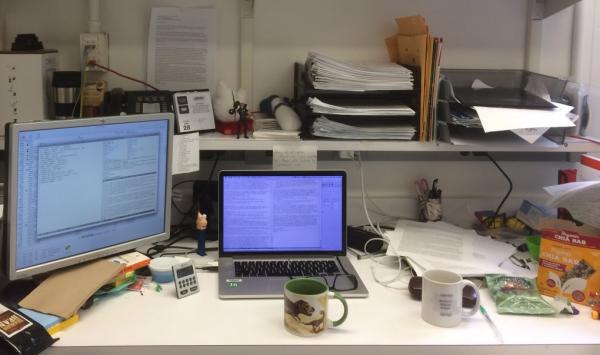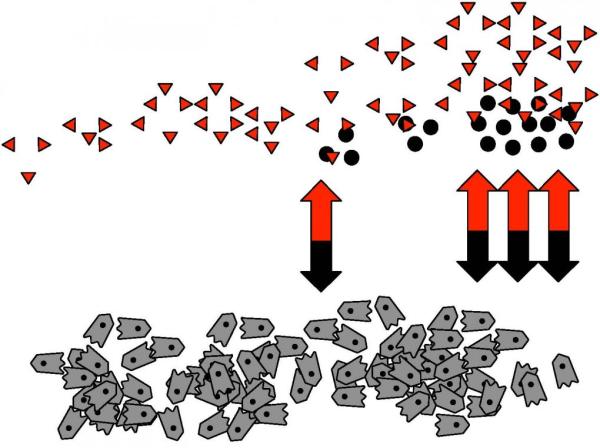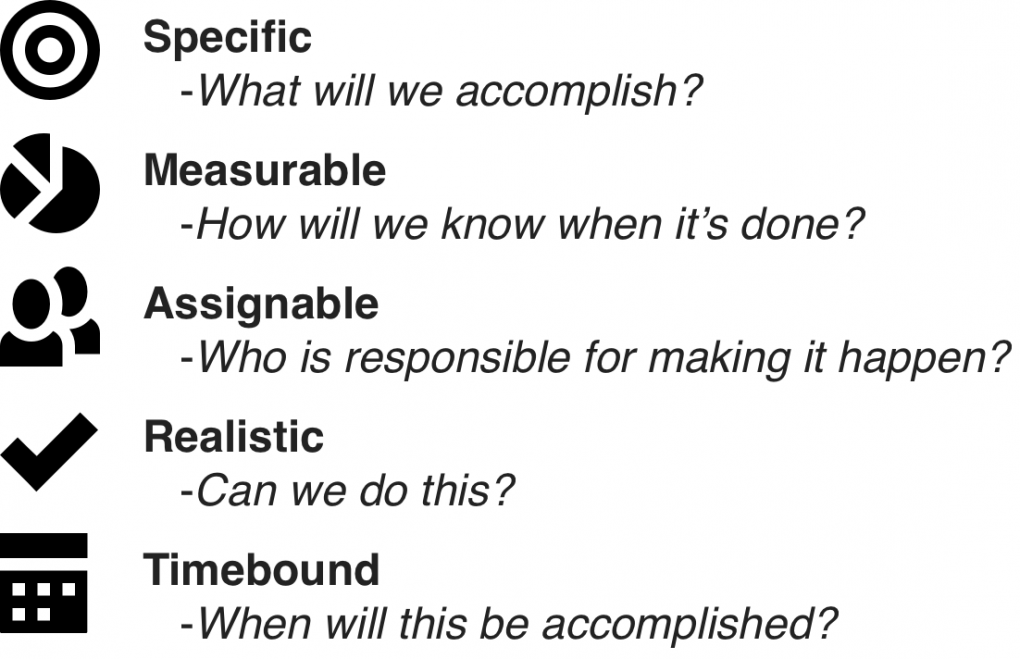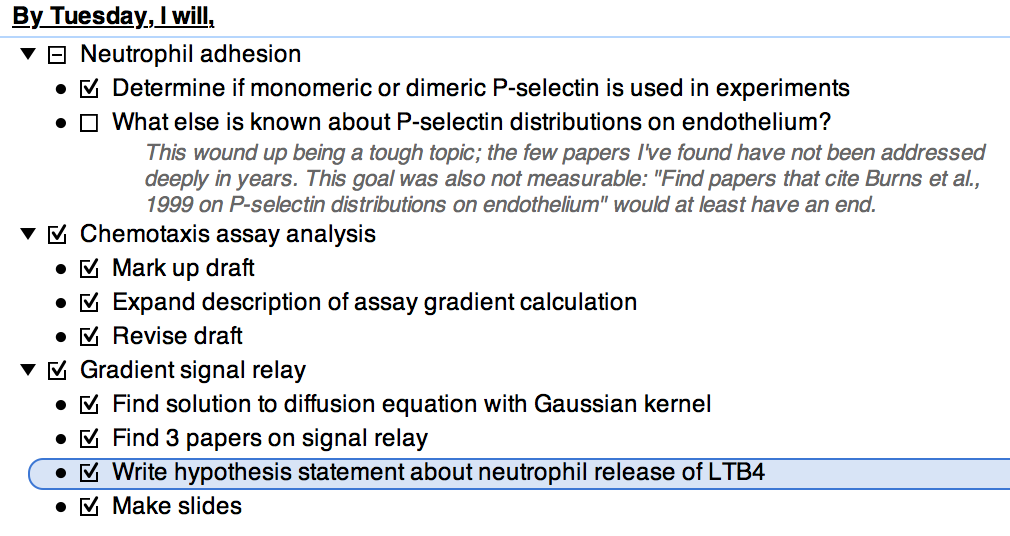Using SMART Goals to Make Scientific Progress

My well-organized desk, where SMART goals get completed.
A timer is always running on my desk, as I try to complete my current task before it beeps. This makes me sound like an organized, competitive, methodical person—not so! My desk is covered with mugs, stacks of paper, and cables unneeded for years. Email sits unreplied-to for days.
As a theoretician in the lab of Dr. Ralph Nossal (NICHD), I use mathematical modeling to study how cells get to places in the body. Most of my time is focused on completing clearly written goals born from project plans. A system of timers, project plans, and goals keeps me on track to do what I need to do so that I can get back to the fun part of my job that I would happily do for free.
Here is some background information on my research project: When a person experiences inflammation, the body directs white blood cells to the inflammation site. In a process called chemotaxis, white blood cells migrate along a gradient of signaling molecules. During a bacterial inflammation, molecules made by the bacteria spread from the inflammation site. When white blood cells sense bacterial molecules, they secrete their own molecule called leukotriene B4 (LTB4). White blood cells can navigate based on signals received from bacterial molecules, as well as by responding to LTB4. My overarching goal as a member of Dr. Nossal’s team is to determine how LTB4 helps white blood cells coordinate their motion, which may clarify the ways various moving cells communicate in other contexts, such as during development and cancer metastasis.

Upon entering the body, bacterial molecules (black circles) stimulate a nearby population of white blood cells (grey objects) to generate LTB4 (red triangles); the LTB4 reaches other white blood cells that are too far from the bacteria to sense them directly, enhancing the immune system’s response.
A typical research project requires me to:
- read scientific literature on cell migration and signaling
- write computer code to model cell motion and communication
- communicate with experimentalists to determine what measurements we need
- gather, plot, and analyze the data
- collaborate with colleagues to write a paper that will undergo peer review
- manage the paper through the peer-review process
One of my challenges is that I like writing code more than I like writing prose, and so I can spend a long time working with nothing publishable to show. Writing goals and scheduling my time helps me bridge that gap between purpose and results, to make the most productive use of my time as an IRP postdoc. I wanted to make sure that I limit my coding efforts to what will be relevant to the paper and make steady progress on writing the paper.
Writing and pursuing goals can waste valuable time if the goals are not good. What makes a goal ‘good’? When writing goals, I’ve learned to use the ‘SMART’ criteria to ensure that it’s posed in a way that will move our research efforts forward.
SMART goals are:

In the business world, George T. Dolan pioneered the idea of setting SMART goals back in 1981(1). Since then, multiple authors have adapted his concepts to setting objectives for project management and personal development(2).
Examples of how I employ SMART goals in scientific research:
Specific
Goals should not be ambiguous. First, I write down my overall goal and describe precisely what I’m trying to achieve. What do I want to accomplish?
I avoid goals like “Make plots,” because that’s a big, complex goal. It’s better for me to focus by breaking goals down into smaller, targeted parts:
- “Make plots showing how LTB4 concentration varies over time.”
- “Arrange plots to compare cell motion with and without LTB4.”
- “Fix problems noted by colleagues in draft.”
I clarify my specific outcome before I start, which lets me focus on the “what” rather than the “why” of what I’m doing, while I’m doing it.
Measurable
How do I know when a goal is complete? By evaluating my progress. Each goal I write has a series of objectives that help me make small steps toward achieving the overall goal. These objectives are precise, concrete, and measurable.
Questions I ask when writing my goals include:
- “How am I going to accomplish this goal?”
- “What will I do or learn in the process?”
- To figure out if a goal is measurable, I ask, “How will I know when this is done?”
A goal like “Read papers on chemotaxis” can never be completed—a quick search of PubMed for ‘chemotaxis’ pulls up 36,039 papers. On the other hand, “Read three review papers on chemotaxis” is something I can do this afternoon if I start now. In scientific writing, goals that include word counts can help, because they’re objective and precise, but I prefer goals like, “Write paragraph on results for cell recruitment in early inflammation.”
Measurable doesn’t have to mean completely objective; a goal only has to be clear enough for me to know when I’m making progress on it and when it’s time to stop and do something else.
Assignable
Who is responsible for making the goal happen? Are expectations clear and agreed upon by all interested parties? On a team collecting and analyzing data, it’s important to identify not just who has which role, but what condition the data should be in when it’s passed from the collectors to the analysts.
Most of the goals I write are assigned to me, but I also record to-dos to remind me to check on things I have asked others to do:
- “Who said they would give me feedback on my paper, and by when? Do they have everything they need?”
- “Did that order for printer toner get made? If not, what needs to happen?”
- “Has my summer student completed a draft of his poster?”
Realistic
Can I achieve this goal with my current skills and resources? If not, is it feasible to acquire the necessary skills and resources in the goal’s established time frame? Is the time frame appropriate to the complexity and amount of effort the goal requires?
Goals are made to be achieved:
- “Write subsection on modeling LTB4 transport today” is doable.
- “Write methods section this week” could be realistic, but “Write results and discussion today” probably is not.
Writing unrealistic goals leaves me discouraged when I don’t meet them, so I write goals that I’m confident that I can accomplish. Having a realistic plan lets me tell my collaborators when they can count on having things finished.
Time-bound
I establish a timeline for completing each goal and assessing progress. Is the timeline relevant to my current deadlines, and does it reflect my long-term objectives?
Many goals have a deadline built in, sometimes recurring. For example, I have a poster session coming up at the NIH Research Festival, and I need to prepare weekly lessons for a class I’m teaching. Some projects don’t have a hard deadline, but if I feel like I need to rush to finish a paper before I send out a grant application, it might be too late already.
Similarly, making a career move takes lots of preparation. I’m in the middle of my search for a tenure-track position at a predominantly undergraduate institution. To figure out my career goal, I arranged informational interviews with people in my network. I took workshops on teaching and then taught a class twice through FAES. Then, I prepared a job package and improved it with feedback from friends and mentors. All that could not have been done in the last few months of a fellowship.
I regularly review my plans to clarify what I need to do now rather than next week, even for projects that seem open-ended. It’s fine to have big goals like “submit paper before November,” but I usually break large goals down into things that can be finished in 30 minutes to four hours of work. Tasks much shorter than half an hour can actually take more time to keep track of than to do, so I group related short tasks into a single goal. On the other hand, gauging progress on goals that take more than half a day can be difficult, unless broken down into smaller steps.
Below is an example of my goal tracking in practice, with some notes included on why one of my goals was not achievable as written:

I don’t plan projects and keep track of goals because this way of thinking comes easily to me; I have to track goals explicitly, because I don’t automatically know what needs doing. Benefits of using the SMART criteria when planning and assessing goals include:
- Making it easy for me to figure out what to do next
- Determining what doesn’t really need doing, or what doesn’t need doing right now
- Managing expectations with my mentor and co-workers
- Sensing when it’s time to take a break or work on a fun side project
Research feels slow sometimes. It can also feel intimidating to start writing a manuscript. One of the most satisfying things to me about tracking goals is that, when I feel like I’m not making progress fast enough, I can look at my records and see how much I’ve actually accomplished.
This spring, I used SMART goals to lay out what is needed to turn my modeling work into a paper. Specific, measurable, and assignable goals helped my collaborators understand what data I needed from them on how neutrophils secrete LTB4, which also helped them predict what data they would have to present at a conference. Realistic and time-bound goals clarified our options as we decided which hypotheses to test. Two months later, we have drafted a paper we are close to submitting for review.
Thank you to Jennifer Patterson-West for contributing significant efforts to this post.
References
1. Doran, G. T. (1981). "There's a S.M.A.R.T. Way to Write Management's Goals and Objectives", Management Review, Vol. 70, Issue 11, pp. 35-36.
2. Fuhrmann, C.N., Hobin, J.A., Clifford, P.S., and Lindstaedt, B. (2013) “Goal-Setting Strategies for Scientific and Career Success.” Science Careers. http://sciencecareers.sciencemag.org/career_magazine/previous_issues/articles/2013_12_03/caredit.a1300263
Additional Resources
- San Diego Continuing Education. ”SMART Goal Setting”
- http://cds.sdce.edu/decision-making/SMART-Goal-Setting
- This webpage has some useful worksheets for setting S.M.A.R.T. goals and provides a more detailed description of the concept.
- Wake Forest University. Office of Personal & Career Development. “SMART Goal Setting Instructions”
Related Blog Posts
This page was last updated on Monday, January 29, 2024
